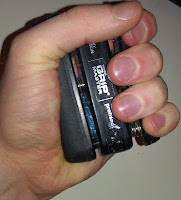Even as I begin to type this, I'm getting reports of success stories from the use of kinesio taping, however, there seems to be a lack of understanding of how kinesio taping works anatomically, and of robust studies testing it's use.
Traditional taping is using zinc oxide tape and is what is commonly used with climbers to tape fingers etc, and is generally used to prevent a certain movement, for stabilization and support.
Kinesio taping, according the the Kinesio Taping Website, "is applied over muscles to reduce pain and inflammation, relax overused or tired muscles, and support muscles in movement on a 24-hour-a-day basis. The taping is non-restrictive and allows for full range of motion"
The tape is basically an elasticated therapeautic tape.
More information on Kinesio taping and how it is supposed to "lift the skin microscopically" is widely available on the web, but I'm going to now look more at the evidence published.
I will stick to kinesio tape applied to the shoulders, as I feel this is an area appropriate to climbers, rather than the lower limbs. I have also tried to look at the most recent papers I have access to, and a variety of outcome measures tested.
First paper I will look at compares kinesio taping to a programme of physiotherapy modalities for the treatment of shoulder impingement. This study compared 30 patients in the kinesio taping (KT) group to 25 patients in the physiotherapy (PT) group (5 dropped out in the PT group and were not included in the final data analysis) between the ages of 18-70 years old.
Both groups had a home exercise programme. The PT group had daily intervention of TENS, exercise, ultrasound and hot pack. The KT group had just the home exercise programme and the taping, for a 2 week period.
There were no significant differences between groups at baseline.
DASH scores (Disability of Arm, Shoulder and Hand) and pain scores decreased significantly in both groups compared to baseline.
The pain scores for the KT group were significantly lower than the PT group at 1 week, but no significant differences were found at 2 weeks.
Therefore, this study found that kinesio taping is comparable to physiotherapy treatment for the treatment of shoulder impingement, but has a more immediate affect on pain scores.
From a cost implication point of view, the kinesio taping was only applied 3 times in the 2 week period, compared to daily treatment of the PT group, therefore the kinesio taping could be seen as a more cost effective method to reach the same end-point.
The second study I have read consists of 42 18-24 year olds complaining of shoulder pain. This study compared kinesio taping to a sham application of kinesio tape over a 6 day period with 2 applications of the tape.
This study was more robust that the previous study, with the participants randomly assigned to the groups and the study procedure being double-blinded.
They found that there was only a slight increase in shoulder abduction range of movement on initial application of the tape, but no significant differences were found after 6 days for range of movement, pain intensity or disability score compared to sham tape.
There was also no control group for comparison, and it must be noted that it has been widely published that taping has a high placebo affect (in the case of taping for patellofemoral pain).
The third study looked at kinesio tape vs placebo taping again, in 17 baseball players with subacromial impingement. There were randomly assigned to the kinesio tape or placebo group first, and performed both interventions.
Outcome measures consisted of muscle activation, strength and scapula range of movement.
The study found that kinesio tape increased lower trapezius muscle activation and strength but it is unclear whether this was significant change, and whether this is a beneficial change to the participant.
Finally, I also read a meta-analysis on kinesio taping in treatment and prevention of sports injuries, and they found similar results to me (regarding slight increase in range of movement), just in a much more scientific manner!
So, in conclusion, I still think that the evidence is weak for kinesio taping, but it has been shown to have a short term effect on range of movement of the shoulder abduction.
This doesn't mean I don't think it works, but it is difficult to measure the effect placebo taping has.
Please feel free to share any anecdotal stories of success with kinesio taping.
For further reading on how Kinesio tape works, see the following links:
How Stuff Works.com
Kinesio website
Paper's Reviewed:
- Kaya E, Zinnuroglu M, Tugcu I 2011 Kinesio taping compared to physical modalities for the treatment of shoulder impingement syndrome. Clinical Rheumatology 30:201-207
- Thelen M, Dauber JA, Stoneman PD 2008 The clinical efficacy of kinesio tape for shoulder pain: A randomized, double-blinded, clinical trial. Journal of Orthopaedic and Sports Physical Therapy 38(7):389-395 (9 /10)
- Hsu YH, Chen WY, Lin HC, Wang WTJ, Shih YF 2008 The effects of taping on scapular kinematics and muscle performance in baseball players with shoulder impingement syndrome. Journal of Electromyography and Kinesiology 19: 1092-1099 (4 /10)
- Williams S, Whatman C, Hume PA, Sheerin K 2012 Kinesio taping in treatment and prevention of sports injuries: A meta-analysis of the evidence for its effectiveness. Sports Medicine 42(2): 154-164 (Level of evidence not applicable due to being a meta-analysis)
(The number in brackets equates to how high the level of evidence scores)



























